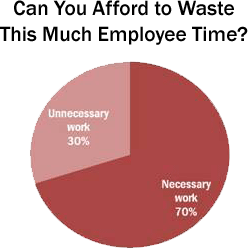

Over-employment is a primary cause of office/service process defects. |

STREAMLINING Why is there so much wasted activity in office and service environments? Here’s just a sampling of the reasons.
Can you afford to waste 20% to 40% of O/S staff time? Reducing work complexity eliminates substantial work while simplifying more. That frees up substantial staff time. In fact, on average we’re able to show clients how they could reduce O/S staffing by 15%, sometimes more. Over-employment contributes mightily to O/S malfunction What about substituting automation technology for process design? In fact, this “technology first” approach to office process typically increases staffing requirements rather than reducing staff size. Of course, redesigning office process does require some investment, and most senior managers are reflexively averse to “spending money to save money.” The good news is that properly executed O/S process redesign provides almost immediate payback–then becomes an annuity that continues paying off indefinitely. The Visual Workflow “trifecta” You might assume that fewer office employees would accomplish less work. Don’t. Streamlining process accelerates work by eliminating stops and delays. You might also assume that having fewer people would decrease work quality. Not so. Properly designing O/S work eliminates sources of work defects, which typically lie “in the seams” between employees, between functions, and between workers and external stakeholders including customers and suppliers. And it might not be obvious that cleaning up office process would significantly and positively affect customer relationships. But when companies try to be customer-friendly, most focus on improving the customer experience at point of contact, not all the support work required to build and maintain customer relationships. In fact, what happens out of customers’ sight usually affects their experience as much or more than direct contact. In some sectors, such as financial services, back office process can become a dominant factor affecting customer experience. And as business continues migrating to the web, the balance of importance between point-of-contact and behind the scenes keeps shifting towards the latter. Visual Workflow does in fact reduce cost, increase capacity and strengthen customer relationships simultaneously. |
OUTSIDE-IN | VISUAL WORKFLOW | ENTERPRISE COLLABORATION | STREAMLINING | OFFICE/SERVICE PROCESS |
CREATING ALIGNMENT | CRM | FREE DOWNLOADS | PARTNERS | BLOG | ABOUT HYM/SERVICES | CONTACT US | HOME
©Copyright 2004-2009 High-Yield Methods - All Right Reserved
| |

